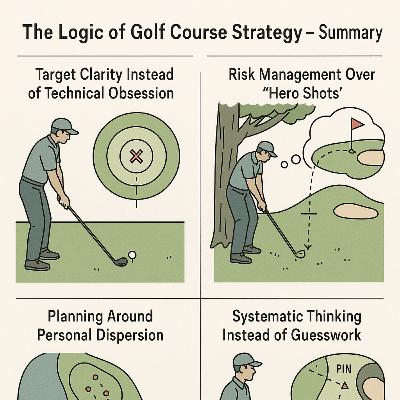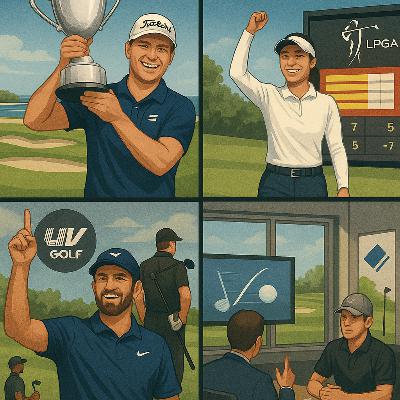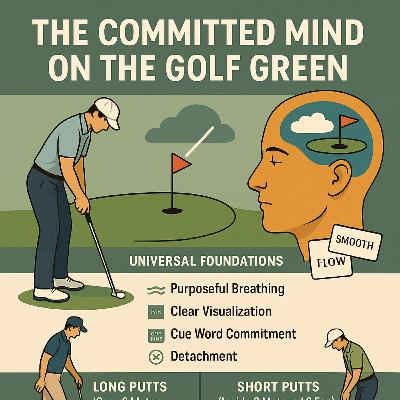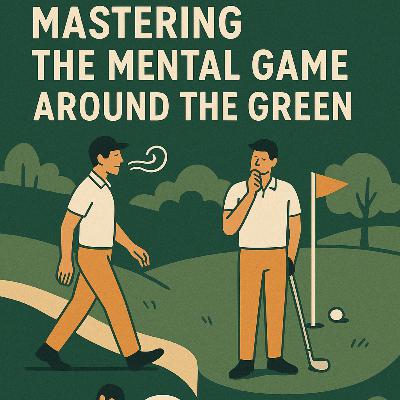Discover Golf 247.eu: The Global Platform for Innovative Technologies and Teaching Concepts.
Golf 247.eu: The Global Platform for Innovative Technologies and Teaching Concepts.

Golf 247.eu: The Global Platform for Innovative Technologies and Teaching Concepts.
Author: Golf247.eu
Subscribed: 0Played: 4Subscribe
Share
© Golf247.eu
Description
Golf247.eu is a technology company that brings together the best teaching concepts in the world into one platform, aimed at connecting golf instructors, academies, clubs, schools, national PGAs, and golf associations. By leveraging cutting-edge tools, it helps these groups deliver better golf instruction, manage their businesses more efficiently, and provide faster services with more time-saving solutions. Golf247 continuously seeks new features from across the globe that can enhance the capabilities of PGAs, golf clubs, academies, and instructors.
460 Episodes
Reverse
By Henrik Jentsch – Golf Academy 360° & AI Golf ChatEvery golf shot begins and ends at one decisive moment: impact. It’s the only point where club and ball connect, and mastering this split second means mastering your game. While many golfers have heard of eight impact factors, the true number is ten—and each one plays a unique role in controlling direction, spin, distance, and strike quality.These ten variables can be grouped into five core categories. Understanding them is the foundation for consistency and improvement.1. Contact Quality (Where the Ball Hits the Clubface)Horizontal Contact (Heel–Center–Toe)Where the ball strikes the face laterally dictates energy transfer and curvature. A center hit delivers optimal power and consistency. Off-center hits on the toe may hook or fade due to the gear effect. Heel shots risk slices and even dreaded shanks.Vertical Contact (Thin–Center–Fat)This affects launch and spin. A thin shot, struck too high on the face or low on the ball, leads to low, weak ball flights. A fat shot hits the ground before the ball—draining distance. Clean contact is essential, especially with high-lofted clubs where mis-hits are exaggerated.2. Clubface Orientation at ImpactFace Angle (Open–Square–Closed)The clubface angle is the single most important factor for where the ball starts. An open face points the shot right; a closed face sends it left. Combined with swing path, it defines the shot’s curvature—slice, draw, or straight.Dynamic Loft (Added or Reduced)Dynamic loft refers to the actual loft delivered at impact. Adding loft increases launch and spin—often unintentionally through scooping. Reducing loft compresses the ball better and controls flight, especially with short irons.Gear EffectWhen contact is off-center, the face twists, altering ball flight. More loft amplifies this effect. Even a technically “square” face can produce curve if the strike is on the toe or heel.3. Club Movement Through the BallSwing Path (Outside–In or Inside–Out)The club’s direction relative to the target line influences spin and shape. An outside-in path typically slices; an inside-out path may hook. To hit a desired shape, your path must complement your face angle.Vertical Attack Angle (Steep–Neutral–Shallow)This defines whether the club is descending, level, or ascending at impact. With wedges, a descending angle is ideal. With a driver, a slightly ascending path increases carry and reduces spin.4. Low Point ControlLow Point Location (Before or After the Ball)To compress the ball, the lowest point of your arc should occur just after impact. If it’s too far behind, you’ll hit it fat. Too far ahead? You might top it or lose loft. Tools like AI Golf Chatbot help measure this precisely.Low Point DepthHow deep the club goes into the ground affects strike quality. A proper divot after the ball is ideal—but excessive depth signals swing flaws, like steep shoulders or poor weight shift.5. Clubhead SpeedSpeed alone doesn’t guarantee performance—only efficient speed does. Once mechanics are sound, speed becomes the multiplier. With a driver, more speed means more distance. With wedges, less is often more.The Practical Coaching OrderWhen coaching or self-analyzing, follow this sequence:Contact first (horizontal + vertical),Then swing path and face angle,Followed by attack angle and low point,Only then focus on speed.Getting these fundamentals right—especially contact and face angle—lays the foundation for all ball control. Speed becomes powerful only when it’s controlled.www.Golf247.eu
The first week of December 2025 delivered three notable champions and key shifts across the global golf landscape. On the DP World Tour, Rasmus Neergaard-Petersen claimed the Australian Open at Royal Melbourne with a total of 15-under-par, sealing victory with a clutch birdie on the 18th. It was the Dane’s first professional win and earned him an official invitation to the Masters. Cameron Smith finished one stroke behind after a missed par putt on the final hole.At the Nedbank Golf Challenge in Sun City, Kristoffer Reitan secured his second title of the year, moving him to the top of the Race to Dubai standings, narrowly ahead of David Puig.On the PGA Tour, Hideki Matsuyama produced a dramatic comeback to win the Hero World Challenge in a playoff in the Bahamas. Because the event is an unofficial invitational, his win did not affect Masters invitations or the Race to Dubai.In senior golf, Team Europe dominated the Skechers World Champions Cup. The format awards points on every hole—two for winning the hole, one for second place, zero for third, with ties splitting points. This creates high scoring totals; Colin Montgomerie alone collected 21 points during Sunday singles. Europe finished with 230 points, well ahead of Team USA and the International Team.Tiger Woods’ health update was another major storyline. The tournament host confirmed that there is no timetable for a competitive return. Following spinal disc replacement surgery in October, Woods remains limited to putting and chipping. He emphasized that he is “still a long way” from being tournament-ready and is focused entirely on rehabilitation. A future transition to the PGA Tour Champions remains a possibility, but only once recovery allows more intensive training.A new Masters invitee, a shift at the top of the Race to Dubai, and Europe’s commanding senior victory defined this week—set against the continuing uncertainty surrounding Tiger Woods’ competitive future.📺 The Explainerwww.Golf247.eu
If you’ve been thinking about building your ownindoor golf simulator—or upgrading to the best technology available—this is theperfect moment.Today I’m excited to share an exclusive before-Christmasoffer for anyone looking to take their indoor performance to a world-classlevel.⭐ Buy Apogee or LaunchBox Before Christmas…and receive the full E6 CONNEX APEX SoftwareFREE of charge.This premium package includes access to more than25,000 golf courses, advanced improvement tools, and a complete trainingenvironment that transforms any indoor space into a high-end simulator studio.The value of this software bundle is $450, and it’s included only for purchases made before Christmas.Why Apogee & LaunchBox?Both systems come from TruGolf, one of theworld leaders in indoor golf technology, trusted by professionals, academies,and passionate players everywhere.Apogee delivers tour-level accuracy with advanced photometric tracking, ultra-fast shot processing, and a seamless user experience. LaunchBox is TruGolf’s newest portable solution—simple to set up, extremely accurate indoors, and perfect for players who want reliable ball data and instant feedback anywhere they train. Whether you're outfitting a home studio, buildinga coaching bay, or launching an indoor golf center, this limited-time offergives you both the hardware and software needed to create a complete,professional setup.⏳ Offer ends at midnight on December 24thOrders must be placed before Christmas toreceive the E6 CONNEX APEX package for free.If you’d like advice on the ideal simulatorsetup—space, hardware options, or complete packages such as the Starter, Max,Signature, or Premium Simulators—I’m here to help.(See full simulator systems by TruGolf for reference: Apogee-based setups, projectors, enclosures, turf systems, PC packages, and more.) If you are interested in an APOGEE Launch Monitor or the TrueGolf LaunchBox—whether for home use, an indoor studio, or a professional installation—please feel free to contact me directly. I will be happy to assist you with product selection, pricing, availability, and any special offers. Best regards,Henrik JentschPGA ProfessionalSales Agent – Golf247.eu📱 +49 179 2079832📧info@Golf247.eu🌐 www.puttalyze-app.com⛳ Puttalyze-App: https://lnkd.in/eh-xS74WWhy Apogee & LaunchBox?: www.Golf247.eu
Smart Course Strategy shows that good golf does not begin with the swing but with a clear decision. Every successful shot starts with a precise plan: defining the target, choosing the intended ball flight, and identifying the safest miss. This mental sequence creates the difference between reacting and being in control.At the core of this system is a reliable five-step routine that provides stability under pressure: Decide, Visualize, Feel, Commit, and Reflect. It serves as a mental anchor, ensuring that the player does not act impulsively but prepares every movement with intention.Professional strategy is built on consistent risk management. Instead of choosing maximum power, skilled players prioritize the safest option. For example, with 160 meters to the target and water in play, the professional choice is not a full 7-iron but a controlled 6-iron aimed at the center of the green. The goal is not defensive golf but intelligent error minimization.For distance control, professionals rely on systems rather than pure feel. The Clock Face model assigns specific distances to fixed swing lengths—for example, a 7:30 or 9:00 arm position. This reduces uncertainty and improves performance inside 130 meters. When shaping ball flight, curvature is not created by manipulation during the swing but by setup: to hit a fade, the player aims left, swings along the body line, and keeps the clubface slightly open.Strategic thinking is the blueprint of golf. Without a clear plan, even a technically sound swing loses structure. The pre-shot routine functions like a pilot’s checklist, aligning attention, technique, and confidence before the swing begins.In summary, intelligent golf is built on four principles: precise strategic decisions, a consistent routine as a control mechanism, systematic distance management, and intentional, setup-based ball flight design. Players who master these mental and organizational skills achieve greater consistency, reduce errors, and make better decisions—regardless of their handicap.📺 The Explainer: www.Golf247.eu
Putting makes up nearly half of all strokes, yet traditional instruction offers little more than scattered tips, mechanical debates, and vague “feel.” The Mechanics of Instinct reframes putting as a science-based craft built on neuroscience, physics, and biomechanics. It focuses on how humans actually perceive, predict, and move, replacing guesswork with a structured learning path.Conventional teaching is flawed because it overemphasizes stroke style while ignoring the skills that matter most. Despite the putter being used more than any club, only a small fraction of golf instruction addresses putting. Most advice relies on “lore,” producing streakiness instead of competence. Three core skills remain largely untouched: green reading, distance control, and aim. Teachers claim touch cannot be taught, yet it is governed by tempo and physics. Ninety percent of golfers cannot aim their putter inside the hole from ten feet, often without knowing it.The Mechanics of Instinct integrates three scientific fields.Neuroscience explains how the brain predicts movement and interprets space. A consistent 2:1 tempo allows the brain to “soak in” distance, making touch instinctive. Aiming errors stem not from poor eyesight but distorted perception caused by turning the head incorrectly.Physics defines non-negotiable realities: gravity-based acceleration, optimal delivery speed, and geometric green reading. The Fall Line becomes the reference for every break, replacing apex-guessing with a precise target.Biomechanics creates a stable, repeatable stroke using simple anchors such as a steady lead hip and a fixed “throat line.” The head rotates like an “apple on a stick” to keep the line of sight straight.The system contrasts sharply with the old model. Traditional teaching is engineering-driven, obsessed with stroke shape. The new model centers on the human mover—how perception guides motion. Touch becomes a teachable outcome of tempo, not a mysterious gift. Aiming becomes a perceptual skill rather than “eyes over the ball.” Green reading becomes geometry, not imagination.Most golfers mis-aim because standing side-on distorts spatial perception. Turning the head while looking downward curves the line of sight, creating a false sense of straight. Correct alignment requires a straight-out gaze and a pure head swivel to reveal true aim.Mastery follows an inside-out sequence:Tempo – the engine of distance control.Stroke – a simple, square delivery.Aim – correcting perceptual distortions.Read – using the Fall Line to choose the correct target.By reversing the traditional order of learning, the Mechanics of Instinct produces consistency where conventional tips create confusion.📺 The Explainerwww.Golf247.eu
Die Wintermonate entscheiden darüber, wie gut du im Sommer spielst – und der „Winter Golf Blueprint“ zeigt, wie strukturiertes Off-Season-Training ein stabileres, kraftvolleres und konstanteres Golfspiel aufbaut. Anstatt den Winter als Pause zu betrachten, versteht dieser Leitfaden die kalte Jahreszeit als strategische Phase, in der Technik, Körper, Ausrüstung und Mentalität ohne Ergebnisdruck verbessert werden können.Eine konsequente Indoor-Routine hält die Bewegungsmuster aktiv. Statt hartem Training steht gleichmäßige Wiederholung im Fokus – etwa drei Einheiten pro Woche –, konzentriert auf grundlegende Elemente wie Griff, Takeaway und Transition. So gehen weder Gefühl noch Vertrauen verloren, und die technische Klarheit bleibt erhalten. Systeme wie Sportsbox messen Brustrotation, Beckenshift, Shaft Lean und Side Bend und liefern objektives Feedback statt bloßer Vermutung. Spiegel, Zeitlupenvideo und Launchmonitore stabilisieren korrekte Muster und verhindern die Verstärkung von Fehlern.Die körperliche Vorbereitung bildet den zweiten Pfeiler. Ein trainierter Körper erzeugt reproduzierbarere Mechaniken, und der Winter eignet sich ideal, um Mobilität, Kraft und Stabilität aufzubauen. Tägliche Beweglichkeitsroutinen für Brustwirbelsäule, Hüften und Schultern erhalten die Bewegungsfreiheit; Kraftzirkel verbessern die Gelenkkontrolle; Rotationsübungen mit Bändern oder Medizinbällen entwickeln golfspezifische Power. Trainiert wird der Athlet – nicht nur der Schwung –, damit die Bewegung zum Saisonstart verlässlicher abrufbar ist.Strukturiertes Training stellt zudem sicher, dass technische Fehler korrigiert und nicht gefestigt werden. Durch die Kombination aus Indoor-Drills und Feedback-Technologien lernen Spieler Bewegungen, die auch unter Druck halten. Wenn der Frühling kommt, fühlt sich der Schwung klarer und präziser an, weil seine Basis im Winter erneuert wurde.Das mentale Spiel ist ebenso entscheidend. Visualisierung stärkt die Mustererkennung und bereitet auf Drucksituationen wie entscheidende Putts oder anspruchsvolle Drives vor. Fokusübungen und Quiet-Eye-Training verbessern die Konzentration, während der Winter die ideale Zeit ist, Pre-Shot- und Post-Shot-Routinen zu entwickeln und zu automatisieren. Diese Gewohnheiten beseitigen Unsicherheit und sorgen für Stabilität, sobald der Wettkampf wieder beginnt.Die Off-Season eignet sich zudem perfekt für die Ausrüstungskontrolle. Griffe sollten überprüft und bei Bedarf ersetzt werden. Ein professionelles Fitting stellt sicher, dass die Schläger zu den aktuellen Bewegungsmechaniken passen, und Launchmonitore helfen, verschiedene Ballmodelle anhand von Launch und Spin zu vergleichen. Wer seine Ausrüstung im Winter optimiert, vermeidet Überraschungen im Frühjahr und bringt Material und Technik in Einklang.Wer den Winter wie eine Werkstatt für Leistung nutzt – Technik pflegt, den Körper verbessert, den Geist schärft und die Ausrüstung optimiert –, verwandelt die Off-Season in einen echten Vorteil. Wenn der Sommer kommt, fühlt sich das Spiel stabiler, kraftvoller und geschmeidiger an, weil die Arbeit längst vorher erledigt wurde.Henrik JentschPGA Professional Golf247.eu📱 Mobile: +49 179 207 9832 📧 Email: info@Golf247.eu🌐www.puttalyze-app.com⛳ Puttalyze-App: https://lnkd.in/eh-xS74W
This text explains why traditional, standardized golf models fail: they ignore a player’s Intrinsic Dynamics — the natural movement blueprint defined by joint structure, arm behavior, and rotational tendencies. To create truly individualized coaching, the system introduces the 3x3 Swing Archetype Model, which classifies golfers using two core elements: Upper Body Types (arm and shoulder mechanics) and Lower Body Dynamics (pelvic rotation and the key biomechanical value known as the sway gap). The model is supported by the AI Golf Chatbot, which provides real-time 3D data across more than 35 parameters.The matrix shifts instruction from a correction-based approach to precision-guided improvement. Many so-called swing faults are simply mismatches between the player’s technique and their physical design. Once a coach understands a player’s intrinsic movement patterns, the golfer no longer works against their own body — a crucial factor for consistency under pressure.The Upper Body Types include:On Top: Shoulder-dominant movers with deeper hand paths and a steeper transition.Under: Forearm- and elbow-driven movers with strong forearm rotation and a naturally flatter shaft.On the Side: A neutral blend of arm and shoulder motion.The Lower Body Dynamics are defined by pelvic rotation and the sway gap, the lateral distance between the chest and pelvis centers.Large sway gap (≥8"): Linked to in-to-out paths and draw patterns.Small sway gap (≤4.5"): Common among players who produce fades or cuts.Combining both systems creates nine complete swing archetypes, each with specific matchups for grip, setup, shaft pitch, and rotational strategy. A player with an “On Top” pattern requires different drills than an “Under” mover; using the wrong drills creates instability and limits performance.A major strength of the matrix is long-term safety. Forcing mechanics that contradict a player’s natural blueprint leads to overuse, inconsistency, and burnout. A swing built in harmony with the body becomes more efficient, powerful, and repeatable.The sway gap also acts as a precise indicator for rotational efficiency:Setup: 2–4" is considered neutral.Impact: The gap strongly predicts shot shape (draw vs. fade).Overall, the 3x3 Swing Archetype Matrix treats the swing not as an aesthetic model but as a biomechanical identity, making instruction more accurate, sustainable, and body-compatible than any traditional teaching method.www.Golf247.eu
Traditional aids like the Visio Arc train a pretty, symmetrical stroke, but they ignore the real forces that decide whether a putt drops: slope, speed, aim, ball position, and impact. A stroke can look perfect and still miss because putting is governed by physics, not aesthetics.Mechanical training creates the illusion of a “Perfect Stroke,” yet the ball starts on line only if the face is delivered correctly. A stroke that rotates 0.8° open one inch before impact and 0.8° closed one inch after is highly sensitive to timing. A 10% faster downswing or a ball positioned just one inch off changes impact location and face angle—enough to miss the hole by two inches from ten feet. Even tiny setup errors, such as shoulders closing by 1° or a subtle wrist flex of 0.06", can twist the face more than a degree.True consistency comes from understanding five measurable variables:Face Angle at Impact – over 80% of start direction.Ball Position on the Arc – determines natural face orientation.Setup Consistency – posture and alignment dictate path.Biomechanics – wrist stability, face rotation speed, and twist.Tempo – timing controls where impact occurs within the arc.To move beyond “pretty motion,” a modern system integrates Puttalyze and Quintic. Puttalyze calculates the physics of the putt: green speed, slope percentage, putt geometry, Aimpoint, Distance Point, and total required roll. It removes guesswork and provides exact aim and pace targets based on real conditions.Quintic validates execution. It measures face angle, path, tempo, rotation speed, impact timing, skid, spin, and dynamic loft with high-speed precision. It exposes silent errors invisible to the eye—twist, off-center strikes, and microscopic wrist movement—ensuring that the ball launches exactly on the line Puttalyze defines.Together, Puttalyze provides the plan and Quintic confirms the delivery. Putting becomes measurable and repeatable: correct read, correct speed, correct face angle. Motion serves performance, not the other way around.📺 The Explainerwww.Golf247.eu
The modern golf swing is built on biomechanics, precision, and efficient motion patterns. Its central goal is consistent clubface control at impact, achieved by blending two contrasting elements: steep body rotation and shallow arm mechanics. When these movements work together, the body provides stable rotational power while the arms deliver precise face control.The body rotates steeply through the ball while maintaining posture. The chest must stay down, and the pelvis must move back in transition to keep the spine angle intact and avoid early extension. This rotation only works if the golfer “earns the shallow” by keeping the club slightly steeper in the backswing, creating space for the arms to shallow naturally.The arms manage the shallowing action and the clubface. During transition, the club shallows behind the hands, staying on plane. Lead wrist flexion—keeping the wrist flat or slightly bowed—squares the face early and keeps it square through impact. Trail shoulder external rotation supports this delivery, with the trail elbow remaining in front of the seam and below the lead elbow.Posture maintenance is equally essential. Lowering the chest and driving the pelvis back preserves spine angle and allows the body to rotate without stalling. This combination produces efficient path control, cleaner compression, and consistent delivery.Setup fundamentals support the entire system: the pelvis positioned more over the heels, a balanced athletic stance, and readiness to lower into transition.Training drills reinforce these mechanics. The “cover drill” forces the golfer to maintain posture—choking down on the club and striking the ball only works when the chest stays down and the player avoids early extension. It is a simple pass-or-fail test of postural discipline.Ultimately, the modern swing is not about copying elite players but developing movement patterns that are biomechanically repeatable and compatible with long-term improvement. Steep rotation for power, shallow arms for precision, a flexed lead wrist for face control, and stable posture for consistent delivery form the complete blueprint for the modern golf motion.📺 The Explainerwww.Golf247.eu
Late November 2025 brought fewer tournaments but major structural developments. Two results defined the week: Sami Valimäki claimed his first PGA Tour victory at the RSM Classic, while David Puig delivered a statement win at the Australian PGA Championship. Exhibition events such as The Skins Game added further attention.The central global discussion, however, focuses on the proposed PGA Tour–LIV alliance, a partnership set to reshape professional golf from 2026 onward. LIV Golf has confirmed its switch to 72-hole events, designed specifically to regain OWGR points and restore major-championship access for its players. Early simulations show notable boosts for stars like Bryson DeChambeau. Rory McIlroy called the update “cool,” while the broader debate about competitive integrity continues.At the same time, the PGA Tour is considering major schedule reductions. CEO Brian Rolapp acknowledged internal discussions about cutting the season to roughly 20 events—an adjustment that would dramatically alter the competitive landscape. The report emphasizes that mergers, format shifts, and player movement will drive the next phase of global professional golf.Financial investment continues to surge. The DP World Tour secured the largest title sponsorship extension in its history—a record 10-year agreement, strengthened further through a new technology partnership with AWS. Player-side investment is increasing as well, highlighted by Patrick Mahomes signing a multi-year commercial extension that expands his presence in golf.Broadcasting and production are entering a new era. The LPGA finalized a multi-year media agreement with FM, Golf Channel, and TrackMan, guaranteeing full live coverage beginning in 2026. LIV Golf simultaneously expanded its TrackMan ball-tracking partnership to elevate its broadcast quality. Together, these deals signal rising capital and interest across all major tours.Commercial branding continues to evolve heading into 2026: Bryson DeChambeau with Reebok, Max Homa with Cobra, Rickie Fowler with Puma, along with additional partnerships involving Ernst & Young.The report closes with a forward look: the season-ending stretch begins with Tiger Woods’ Hero World Challenge, the traditional kickoff to the winter golf swing.📺 The Explainerwww.Golf247.eu
Many older golfers struggle with fading distance, but the real cause is often not the body — it’s the wrong golf ball. A lot of players choose high-compression “tour balls” because the professionals use them. Yet these balls are built for extremely high swing speeds that most senior golfers no longer produce. With a swing speed of 70–85 mph, the ball cannot compress properly, energy transfer stays low, the launch is flat, the feel is harsh, and 20 to 40 yards disappear instantly.Compression describes the ball’s resistance to deformation at impact. A soft ball compresses easily, stores energy efficiently, and releases it again. A firm ball needs tremendous force to activate. For golfers with moderate swing speeds, only a ball that compresses easily delivers maximum distance and a stable ball flight.The common mistake among seniors is choosing high-compression balls, complex multilayer designs, or high-spin models. These products only perform correctly at high speeds. If the inner layers do not activate, the result is inconsistent distance, excessive spin, or “ballooning” — a shot that climbs too high and falls short. Even worse, cheap balls with low-quality cores lose their balance quickly, producing unpredictable distances.The solution is simple: low-compression balls between 35 and 65. These models compress easily at moderate speeds, generate more ball speed, launch higher, and add significant carry distance. Many golfers gain 15 to 40 yards immediately. At the same time, feel improves, the flight becomes more stable, and the entire game becomes easier to control.The key is choosing the ball that fits your swing — not changing your swing to fit the ball. A soft, highly visible two- or three-piece ball allows you to use your potential fully and regain distance without altering your technique. Senior golfers benefit the most from this adjustment because the right ball is the simplest, fastest, and most effective way to recover lost yardage and play with more confidence.www.Golf247.eu
Puttalyze is built to make short putts more precise and repeatable by combining exact green reading with controlled ball speed. Its core elements are the Aim Point and the Distance Point — where the ball must start and how far it should roll past the hole to achieve the highest drop probability.The process begins with a theoretical calculation. Three factors — slope, the angle of the putt relative to the fall line, and distance — create an ideal break value. But this geometric number never reflects reality on its own, because friction, surface texture, and green speed all influence how the ball actually rolls.Puttalyze therefore corrects the theoretical value with empirical data gathered from real putting physics. On a Stimp-11 green and a delivery pace of 3–4 revolutions per second, the ball enters a stable roll phase that maximizes the effective size of the hole. A 2-meter putt that appears to require 2.25 balls of break in theory becomes roughly 1.08 balls of break after correction. Only this adjusted number represents the true target line.The system also defines the Distance Point — the ideal rollout beyond the hole. This is approximately 27 centimeters. This controlled rollout creates a stable entry window and prevents the ball from being deflected by micro-breaks, grass resistance, or early energy loss. Too little speed shrinks the effective hole size, while excessive speed reduces the drop angle. The optimal window exists only within the Puttalyze standard pace.To help golfers not only know these numbers but also feel them, Puttalyze connects theory and practice through two tools: the app’s visualization and structured drills. The app displays break, target point, roll line, and rollout exactly as calculated. This builds trust because a golfer can compare personal perception to the true, physics-correct line. Structured drills — such as the “1-Ball, 1-Spot” routine — then train players to execute these numbers with consistent tempo.Regular use of the app shows how personal reads match the actual behavior of the putt surface. This strengthens confidence, improves repeatability, and clarifies why putts fall or miss. Especially on the common 2-meter range, the impact is immediate: clearer targets, predictable pace, and measurable control.📺 The Explainerwww.Golf247.eu
The story of Single Length irons is not a modern trend but a thread that runs across an entire century. Their core principle—uniform shaft lengths for all irons, one setup, one swing—was born long before Bryson DeChambeau ever entered the spotlight. As early as the 1920s and early 1930s, Bobby Jones played a nearly uniform Spalding iron set, delivering the first historical proof that standardization in the bag can produce elite performance.Jones chose a set with minimal length variation, balanced swing weight, and consistent feel. This allowed him to maintain almost identical swing mechanics and identical setup across the entire set. In an era without standardized club manufacturing, his configuration was a quiet technical revolution—and Jones used its advantages with absolute mastery. In 1930, he became the only player in history to win the true Grand Slam. His achievement showed clearly that a consistent motion reduces errors and holds up under pressure.The underlying principle remained unchanged for decades: fewer variables mean greater repeatability. That idea is the foundation of today’s Single Length philosophy. But the road to mainstream acceptance was long. In the late 1980s, Tommy Armour attempted to bring the concept to the mass market with the EQL set—without a tour ambassador, without refined weighting, without technical solutions to distance issues in the long irons. The result: a good idea at the wrong time.The real renaissance began in 2015. Bryson DeChambeau won both the NCAA Championship and the U.S. Amateur using a custom-built One Length set, delivering the long-awaited validation at the highest level. When Cobra Golf introduced the King F7 One Length in 2016, the company combined this momentum with modern engineering: optimized lofts, precise CG positioning, tungsten weighting for higher launch in long irons, and heavier heads in the wedges. With this, they achieved what others could not—a uniform set that still delivers proper distance gapping.Today, the concept stands for one clear advantage: a single swing instead of many variations. Whether through Bobby Jones’s historic Grand Slam or DeChambeau’s modern victories, the idea has proven for 100 years that less complexity creates more consistency.📺 The Explainerwww.Golf247.eu
The Launchbox from TruGolf is an ultra-portable launch monitor designed to deliver precise golf performance data for players and coaches. Using high-speed photometric camera technology, the device captures detailed ball and club metrics—previously available only in high-end studio systems. With dedicated Ball and Club Modes, it measures spin, launch angle, carry distance, face angle, club path, and attack angle either separately or in a combined view.A standout feature is the integrated E-Ink display, which presents key shot data directly on the unit. No smartphone, app, or computer is required. The display remains perfectly readable even in bright sunlight. Weighing only 1.4 kg, the Launchbox is extremely compact and offers up to six hours of battery life—ideal for indoor use, outdoor ranges, on-course sessions, studio training, or travel.Benefits of PortabilityThe Launchbox is lightweight, fits easily into any golf bag, and works seamlessly at home, on the range, or in a professional studio. It enables flexible coaching, mobile training, and fast setup with immediate data feedback.Benefits of Autonomous OperationThe device functions fully on its own. The E-Ink display delivers instant shot feedback immediately after impact. This makes it ideal for lessons, quick practice sessions, or players who want fast, uninterrupted information without external devices.Technological InnovationsHigh-speed photometric imaging for accurate ball and club trackingClub Mode for face angle, club path, attack angle, clubhead speedBall Mode for spin, launch angle, ball speed, carry, and directionLED-enhanced 4 × 8-inch hitting zone for reliable data captureDurable, lightweight construction for maximum mobilityExclusive Club Mode MetricsFace AngleClub PathAttack AngleClubhead SpeedThese measurements are essential for diagnosing issues such as face-to-path errors or swing direction problems.Utility of the E-Ink DisplayIt shows live shot data clearly without glare, works in all lighting conditions, and allows completely independent operation without additional hardware.Price & Base Package Contents (USD 2,999)Launchbox unitAccess o E6 Range virtual training software📺 The Explainerwww.Golf247.eu
Effective course strategy is built on clear decisions, not perfect swings. Every shot begins with defining a precise landing point: where the ball should finish, which risks must be avoided, and what leaves the best position for the next shot. Amateur golfers benefit the most from minimizing mistakes rather than attempting heroic recoveries.1. Target Clarity Instead of Technical ObsessionStrategy starts with a precise decision: not aiming at the flag, but choosing the smartest landing zone. Skilled players plan the next good shot, not the perfect one. They understand their dispersion pattern and base their strategy on it.2. Risk Management Over “Hero Shots”The most important rule for amateurs: avoid double bogeys. In trouble, the smart decision is to get the ball safely back into play, not to attempt a miracle shot through trees. Even professionals choose the safe option because it consistently produces better scores.3. Planning Around Personal DispersionEvery shot has a natural width. Strategy means placing the center of your dispersion in an area where even slight misses still produce acceptable outcomes. This creates a “safe landing area” that reduces pressure and builds consistency.4. Systematic Thinking Instead of GuessworkMethods like DECADE turn strategy into clear numbers. They evaluate distance, handicap, wind and hazards to define a precise target, such as “13 yards right of the pin.”Club selection follows the same logic: choose the club whose full dispersion most likely hits the green.5. Intelligent AlignmentThe real target is the landing point, not the flag. To align consistently, use a small spot just in front of the ball—like a leaf or blade of grass—as a reference. This increases setup stability and repeatability.6. Green Reading – The Water RuleA simple way to understand slope is the “Water Rule”: imagine where water would flow. This reveals the true downhill direction. Since slope affects the ball most as it slows near the hole, this understanding improves both line and speed control.Strategic ConclusionCourse strategy connects technique to intelligent decision-making. Golfers who control risk, account for dispersion, and choose safe, high-percentage targets consistently score better—even without swinging better.🎧 Listen nowwww.Golf247.eu
Indoor-Golf gewinnt stark an Bedeutung, besonders in Europas kalten Monaten. Es bietet eine wetterfeste, ganzjährige Trainingslösung, wenn Regen, Schnee, Kälte und frühe Dunkelheit Golf im Freien erschweren. Moderne Systeme wie TrackMan, FlightScope, Foresight oder TrueGolf LaunchBox liefern hochpräzise Daten zu Schwung, Ballflug und Körperbewegung. Damit entsteht eine vollständig datenbasierte Trainingsumgebung, die Amateuren, Profis und Trainern gleichermaßen zugutekommt.Technologische GrundlagenHochpräzise Launch-Monitore messen Ballgeschwindigkeit, Spinrate, Abflugwinkel, Schlägerpfad und Schlagflächenwinkel mit extremer Genauigkeit. KI-gestützte Tools wie AI Golf Chat und Sportsbox AI 3D analysieren Bewegungsmuster und decken Schwachstellen wie angle of attack oder smash factor auf. Spezialsysteme wie Puttalyze, Quintic Ball Roll und Zenio ermöglichen millimetergenaue Putting-Analyse. Simulatoren bieten realistische Visualisierungen weltbekannter Plätze wie Pebble Beach, St. Andrews oder Valderrama.Ganzjähriges Training und EffizienzIndoor-Golf eliminiert die Winterpause. Spieler bleiben 12 Monate im Rhythmus, halten Technik und Timing stabil und bereiten sich ohne Unterbrechung auf die neue Saison vor. Trainingseinheiten dauern oft nur 30–60 Minuten und lassen sich perfekt in volle Zeitpläne integrieren. Die kontrollierte Umgebung eignet sich ideal für strukturiertes Training, Gruppenkurse und Anfängerprogramme.Vorteile für verschiedene ZielgruppenAmateure bleiben im Winter konstant und verlieren keine Form. Wettkampfspieler und Pros arbeiten gezielt an Technikdetails. Anfänger profitieren von einer ruhigen, fokussierten Umgebung. Coaches nutzen stabile Indoor-Setups für Analyse, Einzelunterricht und digitale Coaching-Modelle. Clubs generieren zusätzliche Einnahmen in der Nebensaison und können Events, Online-Turniere und „Closest to the Pin“-Formate anbieten.Motivation und realistische BedingungenSimulatoren schaffen eine spielerische, motivierende Atmosphäre. Virtuelle Plätze fördern Abwechslung, während genaue Daten schnelle Lernfortschritte ermöglichen. Indoor-Golf wird zu einem effizienten Trainingslabor, das Wiederholbarkeit, Präzision und Flexibilität bietet.Zentrale GeräteLaunch-MonitoreHigh-Speed-KamerasGolf-SimulatorenLeinwand/NetzBiomechanische Analyse-ToolsKurzspiel-Systeme wie Puttalyze, Quintic, ZenioDrei HauptvorteileGanzjahrestrainingTechnische PräzisionRealistisches PlatzspielStrukturiertes TrainingGezielte Pläne, Feedbackschleifen und klare Übungen beheben Schwächen, steigern Konsistenz und verbessern Technik. Spieler gewinnen Selbstvertrauen und starten im Frühjahr mit einem deutlichen Wettbewerbsvorteil.Indoor-Golf ist damit eine zukunftsorientierte, wetterunabhängige und hochpräzise Trainingsform, die langfristige Entwicklung optimal unterstützt.📺 The Explainer: www.Golf247.eu
Indoor golf is rapidly growing, especially during Europe’s cold months. It offers golfers a weather-proof, year-round training environment when rain, snow, low temperatures, and early darkness make outdoor play difficult. Modern simulators combine high-speed cameras, launch monitors, and advanced software to create a precise, data-driven training space that benefits amateurs, professionals, and coaches alike.Precision Through TechnologyAdvanced systems have transformed golf instruction from visual judgment to measurable analysis. High-end launch monitors such as FlightScope, TrackMan, Foresight, TrueGolf LaunchBox, and Sportsbox AI capture ball speed, spin rate, launch angle, club path, and face angle with extreme accuracy. AI-based biomechanical tools like AI Golf Chat and Sportsbox AI 3D analyze movement patterns and help players target flaws such as angle of attack, swing path, and smash factor. Short-game technology—Puttalyze, Quintic Ball Roll, Zenio—provides millimeter-precision feedback for putting.Accessibility and Year-Round TrainingIndoor golf eliminates the traditional winter break. Golfers can train consistently 12 months a year, maintain rhythm, and prepare for the new season without interruption. Sessions are highly time-efficient, often taking only 30–60 minutes, making them ideal for busy schedules. Controlled indoor environments are perfect for structured coaching programs, group training, and beginner development. Simulators also offer realistic virtual course play, giving access to world-famous layouts like Pebble Beach, St Andrews, or Valderrama.Competitive Advantages for GolfersIndoor training provides consistency, precision, and repeatability. Players build confidence during the off-season, fix weaknesses, and return in spring with a competitive edge. Data-driven insights speed up improvement and allow targeted practice sessions that are impossible on a normal driving range.Economic Advantages for Facilities and CoachesIndoor golf generates valuable off-season revenue and supports new digital coaching models. Facilities can host online tournaments, group events, and fun formats such as "closest to the pin." Coaches gain new income streams through remote lessons, analysis packages, and structured winter programs.Key Technologies MentionedFlightScopeTrackManForesightTrueGolf LaunchBoxSportsbox AIAI Golf ChatSportsbox AI 3DPuttalyze-AppQuintic Ball RollTwo Core Benefits of Indoor GolfYear-round training: No breaks, full consistency, and continuous improvement.Technical precision: Detailed data and repeatable conditions accelerate learning.Indoor golf has become a smart, future-focused investment—transforming golf into a fully accessible, measurable, and weather-independent sport.📺 The Explainerwww.Golf247.eu
The late-November Global Golf Report highlights major results and strategic positioning across the world tours as all circuits prepare for 2026. Sami Välimäki’s breakthrough at The RSM Classic delivered the first PGA Tour title of his career, granting him full exempt status through 2027 and entry into the 2026 Masters. On the LPGA Tour, Jeeno Thitikul’s dominant win at the CME Group Tour Championship capped a record-setting season and emphasized the tour’s rising commercial strength.Across the global landscape, tours are adjusting formats, strengthening commercial foundations, and upgrading broadcast technology. A central storyline remains LIV Golf’s structural overhaul and its continuing pursuit of Official World Golf Ranking (OWGR) eligibility. For 2026, LIV confirmed a shift to 72-hole events and the addition of more qualifying spots—changes designed to answer prior OWGR objections. Despite these moves, the OWGR board, led by Trevor Immelman, still cites LIV’s closed format and team structure as core hurdles. Several LIV stars retain major exemptions, but many others risk losing access without ranking points.The LPGA Tour enters 2026 with momentum. Its season finale featured an $11 million purse and the largest winner’s payout in women’s golf history. A new broadcast agreement with FM, Golf Channel, and Trackman will quadruple shot-tracing and increase camera coverage by 50%, positioning the tour at the forefront of televised innovation.The DP World Tour secured long-term commercial stability by extending its title partnership with DP World through 2030—the biggest agreement in its history. Operationally, the tour showed renewed flexibility as Henrik Stenson announced selected appearances for 2026 following his period with LIV.The PGA Tour finalized its 2026 lineup through the FedExCup Fall series. Välimäki’s win propelled him into the OWGR top 50, while rookies such as Michael Brennan and Ricky Castillo strengthened their positions. Commercially, the tour added a new Austin event for October 2025 with Good Good as title sponsor, blending influencer culture with traditional competition. Ongoing debates continue regarding field sizes in Signature Events.Other tours also made targeted adjustments. The Asian Tour introduced qualifying refinements; the Japanese Tour highlighted new regional talent; senior circuits discussed modest format updates. Though activity was limited, these shifts reflect broader global realignment.Business developments remained significant. Callaway sold a 60% stake in Topgolf to Leonard Green & Partners, unwinding their 2020 merger. Equipment and tech partnerships expanded across tours, with Trackman deepening its role in both LPGA and LIV broadcast integrations.Across all circuits, the strategic picture for 2026 is one of structural upgrades: LIV reshaping its format to pursue OWGR legitimacy, the LPGA investing heavily in broadcast modernisation, the DP World Tour securing commercial longevity, and the PGA Tour expanding and refining its competitive framework. Together, these moves set the stage for a season defined by operational evolution, commercial innovation, and increasing pressure for global alignment.www.Golf247.eu
Putting is a mental skill requiring clarity, trust, and emotional stability. The source outlines universal habits shared by consistent putters and explains how long and short putts demand different psychological frameworks. Long putts require imagination and pace control, while short putts test confidence and nerve.Universal FoundationsSuccessful putters rely on four core habits:Purposeful Breathing: Slow breathing regulates arousal and creates calm hands. A common pattern is 4 seconds in, 4 hold, 6 out, 2 pause.Clear Visualization: Seeing the ball roll along the intended line and drop into the hole builds intention.Cue Word Commitment: A simple word such as “smooth,” “roll,” or “trust” silences internal noise and replaces doubt.Detachment: The golfer focuses only on what they can control—the process—not the outcome.Long Putts (Over 6 Meters / 20 Feet)Long putts challenge pace, imagination, and patience. The pressure comes from fear of three-putting or from trying too hard to “make it.”Mental Goal: Roll the ball with committed pace and pure intention, not force. The aim is consistent two-putting, with the occasional make.Process:See the entire journey—distance, slopes, break.Visualize a pure roll finishing close or dropping in.Use rhythm-based cue words like “Smooth” or “Flow.”Make a rehearsal stroke focused only on feel.Step in, trust, and roll the ball without controlling the outcome.If struggling, use “pace-only” drills with no target.Short Putts (Inside 2 Meters / 6 Feet)Short putts trigger fear, tension, and self-consciousness. They are mostly mental, not mechanical.Mental Goal: Make a decisive, confident stroke without steering.Process:Take a settling breath to quiet the body.Choose a precise target—blade of grass, edge of the cup.Visualize the ball striking the back center of the hole at perfect speed.Use simple cue words like “True” or “Firm.”Take one calm rehearsal stroke matching the intended tempo.Step in, align, look at the spot, exhale, and commit.After the stroke, stay neutral—no emotional reaction.Golfers struggling with short putts benefit from three days of one-meter confidence reps.Universal Mental HabitsAcross all distances, consistent putters breathe with control, visualize clearly, use a single cue word, and detach from the result. These habits form the psychological chassis that stabilizes performance whether facing a long, imaginative pace putt or a short, pressure-filled one.How Breathing, Visualization, and Cue Words Drive ActionBreathing stabilizes the body and reduces arousal. Visualization creates the internal blueprint for the stroke. Cue words act as a command that organizes intention. Together, they transform commitment into a simple, decisive action.Long Putt Mental Goal SummaryApproach long putts with feel, patience, and creativity. The purpose is not to force a make, but to produce a confident, pace-controlled roll.Cue Words for Long PuttsRecommended words: “Smooth” and “Flow.” They encourage rhythm instead of force.What Regulates Arousal and Focus?Slow, deliberate breathing. Calm breath equals calm hands.www.Golf247.eu
This guide presents a clear mental framework for handling short-game situations after missing the green. The process is built on two phases: the reset during the walk to the ball and the clarity-driven routine at the ball. It converts reactive anxiety into calm intention through breathing, posture, visualization, and committed decision-making.1. The Walk to the Ball — Resetting the MindThis phase shifts the player from reaction to purposeful focus.• Breathe to Clear: Inhale 4 seconds, exhale 6 seconds, twice. Shoulders drop, tension releases, attention returns to the present.• Verbal Anchor: Quietly say “New chapter” to signal the mental shift away from the previous shot.• Body Posture = Mental Posture: Walk tall with lifted eyes and a steady pace. Strong posture communicates control and reduces rushing.• Explorer’s Mindset: Approach the ball with curiosity: “What’s the opportunity here?” This reframes frustration into problem-solving.By the time the golfer arrives at the ball, tension has filtered out and clarity takes over.2. Arriving at the Ball — Clarity Over ComplexityGreat short-game players avoid overthinking and commit to a simple, repeatable method:Decide, Visualize, CommitAssess Honestly: Evaluate lie, green availability, landing zone, and the safest high-percentage option.Pick the Shot You Can See: Visualize the flight, landing, and roll. If you cannot clearly see it, choose a simpler option.Cue Word: Anchor commitment with a feel-based word such as “Soft,” “Splash,” “Skip,” or “Land.”Rehearse with Intent: One purposeful practice swing that matches the chosen shot, then step in and play without second-guessing.This process uses clarity—not complexity—to stabilize decision-making under pressure.3. Situational Mindsets for Different Lies• Rough:– Emotional Response: Fear of heavy contact.– Mental Reset: “Brush the grass, don’t lift the ball.”– Visual: A clean brush through the grass.• Bunker:– Emotional Response: Distance anxiety.– Mental Reset: “Let the sand do the work.”– Visual: A splash of sand reaching the landing zone.• Fringe / Collar:– Emotional Response: Over-analysis.– Mental Reset: “Keep it low, make it roll.”– Visual: Marble-like roll across a smooth floor.• Semi-Rough:– Emotional Response: Uncertainty.– Mental Reset: “Trust the motion.”– Visual: A crisp strike with a predictable first hop.4. Post-Shot NeutralityTo avoid carrying emotion forward:• Acknowledge neutrally: “Strike was slightly off” or “Good choice.”• Reset with one breath and say, “Next ball.”• Leave the shot behind and take only the lesson.📺 The Explainerwww.Golf247.eu
























